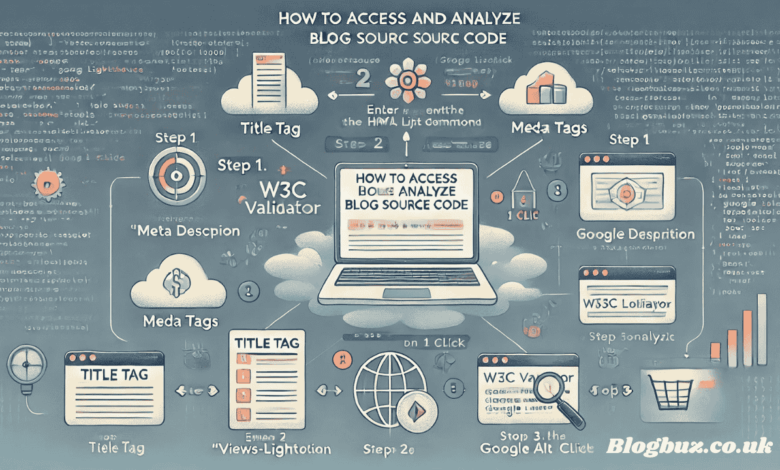How to Access and Analyze the Source Code of a Blog Using views-source:https://roobx4uuu.blogspot.com

The source code of a website is a treasure trove of information for developers, SEO experts, and digital marketers. By viewing the source code, you can gain insights into how a site is structured, its technologies, and how it is optimized for search engines. This article explores how you can access and analyze the blog’s source code “https://roobx4uuu.blogspot.com” using the “views-source” method, providing a step-by-step guide and best practices. Whether you’re a beginner or an advanced user, understanding a blog’s source code can significantly improve your site’s performance.
What Does “views-source” Mean?
The term “views-source” is a command in web browsers to access the HTML source code of a web page. The blog’s source code will be displayed when you enter “views-source:https://roobx4uuu.blogspot.com” in your browser’s address bar. This feature is supported by most modern browsers, such as Chrome, Firefox, and Microsoft Edge, making it accessible for anyone to view the code behind a web page.
Why View the Source Code of a Blog?
Viewing the source code of a blog like “https://roobx4uuu.blogspot.com” has several advantages:
- SEO Analysis: Check if the blog uses the correct HTML tags, such as meta tags, header tags, and alt attributes, which are critical for search engine optimization.
- Web Development Insights: Understand how the site is built, including scripts, stylesheets, and other technologies.
- Content Structure: Evaluate how the content is organized within the HTML structure, which can influence how search engines crawl and rank the site.
- Security Assessment: Review if there are any visible vulnerabilities or outdated scripts that could compromise the blog’s security.
Step-by-Step Guide to Viewing the Source Code of “https://roobx4uuu.blogspot.com”
If you want to obtain the source code of “https://roobx4uuu.blogspot.com” using the “views-source” method, follow these steps:
Open Your Browser
First, open a web browser that supports viewing the source code. Most users prefer Google Chrome, Mozilla Firefox, or Microsoft Edge.
Enter the URL with the “views-source” Command
In your browser’s address bar, type:
Press Enter, and the browser will display the entire HTML source code of the webpage.
Inspect the HTML Structure
Once the source code is displayed, you can begin analyzing various elements. Look for essential tags such as:
- <title>: This tag displays the page’s title, which is crucial for SEO.
- <meta name=”description”>: This meta tag summarizes the page’s content and is essential for search engine rankings.
- <h1>, <h2>, and other header tags help organize the text, making it easy for search engines and users to navigate.
Analyzing the HTML Code of “https://roobx4uuu.blogspot.com”
Title and Meta Description
One of the first elements you should check is the title tag and meta description. These are critical for SEO as they inform search engines about the page’s content. For example:
Ensure the title is concise and includes relevant keywords while the meta description accurately summarizes the page’s content.
Header Tags (H1, H2, H3)
Header tags help to arrange the content of the blog post. The <h1> tag is typically the most important and should be unique to each page. Below it, <h2> and <h3> tags help break down the content into manageable sections.
If “https://roobx4uuu.blogspot.com” uses proper header tags, the blog is well-optimized for SEO.
Internal and External Links
Links are crucial for SEO. Internal links connect different pages within the site, while external links point to other resources. Ensure the blog has a good balance of both types and uses them effectively.
Image Alt Attributes
Images should have descriptive alt attributes to enhance SEO and provide context for visually impaired users. Check if “https://roobx4uuu.blogspot.com” is using alt tags for its images:
Best Practices for Analyzing Source Code
When analyzing the source code of “https://roobx4uuu.blogspot.com” or any other website, consider the following best practices:
- Look for Best SEO Practices: Evaluate whether the site is using important tags like <title>, <meta>, and <alt>. This helps you understand if the blog is optimized for search engines.
- Check for Structured Data: Structured data helps search engines understand the content better. Look for JSON-LD or microdata scripts that may be present in the code.
- Review the Use of CSS and JavaScript: CSS styles the site, while JavaScript adds interactive elements. Analyze whether the site uses minified versions of these files for better performance.
- Identify Any Broken Links or Errors: Broken links or HTML errors can negatively affect a site’s SEO. Tools like W3C Validator can be used to identify issues.
Tools for Analyzing HTML Source Code
Several tools can aid in analyzing the HTML source code of a blog:
- W3C Markup Validation Service: Validates HTML and ensures it follows the standards.
- SEO Meta in 1 Click: A browser add-on that offers a rapid overview of meta tags and other SEO elements.
- Google Lighthouse: A Chrome tool for checking site performance, accessibility, and SEO.
Common Mistakes in Blog Source Code
When viewing the source code of a blog like “https://roobx4uuu.blogspot.com,” watch for these common mistakes:
- Missing Meta Tags: Important tags like meta descriptions and keywords should not be missing.
- Improper Use of Header Tags: Using multiple <h1> tags or not using them at all can confuse search engines.
- Lack of Image Optimization: Not using alt attributes for images or using large image files without compression can slow down the site.
Conclusion
Accessing and analyzing the source code of “https://roobx4uuu.blogspot.com” using the “views-source” method is an effective way to understand the technical and SEO elements of the blog. By following the steps outlined in this guide, you can gain valuable insights into the blog’s structure, identify areas for improvement, and apply similar techniques to optimize your site.
FAQs on views-source:https://roobx4uuu.blogspot.com
What is the purpose of viewing the source code of a blog?
Viewing the source code allows you to analyze the HTML structure, SEO elements, and web technologies used in a blog. This can help you improve your own site’s performance and SEO strategies.
How do I access the source code of a blog using the “views-source” method?
You can access the source code by typing views-source:https://roobx4uuu.blogspot.com in your web browser’s address bar and pressing Enter. This will display the entire HTML source code of the blog.
What are some key elements to look for in the source code?
Look for important HTML tags such as <title>, <meta name=”description”>, header tags (<h1>, <h2>, <h3>), internal and external links, and image alt attributes. These elements are crucial for SEO and content structure.
Why are meta tags important for SEO?
Meta tags provide search engines essential data about a page’s content. The title tag is often featured in search results, while the meta description summarizes the page’s content, influencing click-through rates.
How can I check if a blog uses structured data?
Look for JSON-LD or microdata scripts in the source code. Structured data allows search engines to grasp the material more effectively, improving the chances of enhanced search results.
You May Also Read: Maximizing Local SEO and Business Insights with Google Business Profile KGMID Extractor




